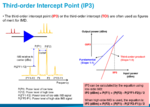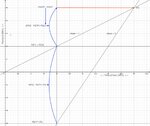promach
Advanced Member level 4

Could anyone elaborate on how to derive the following IP3 equation in the screenshot ?

Note: Extracted from https://www.keysight.com/upload/cmc_upload/All/ENA_IMD_Measurement_Summary.pdf#page=4

Note: Extracted from https://www.keysight.com/upload/cmc_upload/All/ENA_IMD_Measurement_Summary.pdf#page=4




